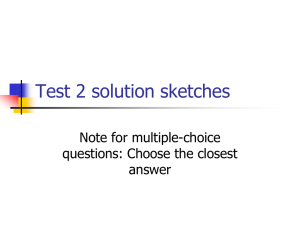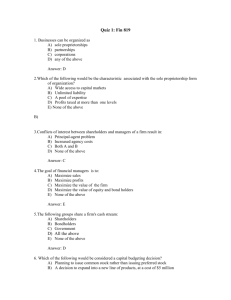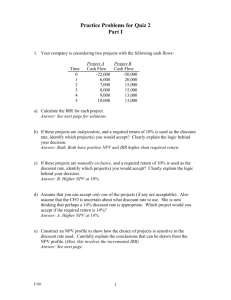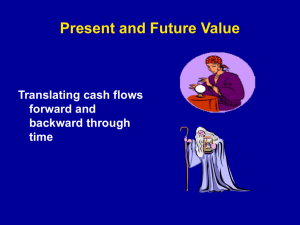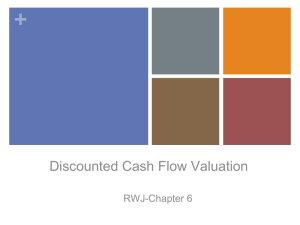here
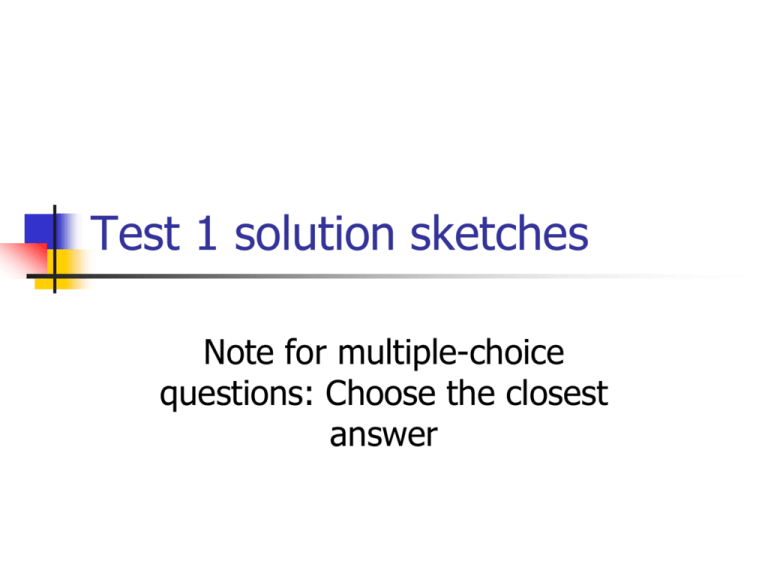
Test 1 solution sketches
Note for multiple-choice questions: Choose the closest answer
Present value calculation
Assume that you receive $600 annually forever. Assume that the effective annual discount rate is 8%. Determine the present value given the following assumptions.
Present value calculation
You receive the first payment today Perpetuity formula assumes first payment is made one year from today We must add in an additional payment today Solution: PV = 600 + 600 / .08 = 8100
Present value calculation
(This was a hard question)
You receive the first payment one year from today, but you receive a payment of $300 every six months This is trickier to do: Two ways to do it Perpetuity every six months (and subtract first payment) Discount the second payment each year before calculating the PV of the annuity
You receive the first payment one year from today, but you receive a payment of $300 every six months
Method 1: Perpetuity every six months (and subtract first payment) Discount rate every six months is sqrt(1.08) – 1 = .03923
PV = 300 / .03923 – 300 / 1.03923 = $7358.44
You receive the first payment one year from today, but you receive a payment of $300 every six months
Method 2: Discount the second payment each year Discounting the second payment by six months: 300 / 1.03923 = 288.68
PV = (300 + 288.68) / .08 = $7358.44
IRR
Suppose Joanne Green invests in a new technology that makes tubeless toilet paper. Her annual discount rate is 8%. Her investment today is $50,000. The only positive cash flow she receives is three years from now, for $58,000. Her annual internal rate of return for this project is…
IRR
50,000 (1 + IRR) 3 IRR = 0.0507
= 58,000
Real payments
Billy Bo Bob is set to receive a nominal payment of $100,000 six years from now. There is no inflation over the next year, followed by 5% annual inflation each of the following five years. The real payment six years from now is _____.
Real payments
No factoring of inflation the first year, 5% each of the following five years Real payment is 100,000 / (1.05) 5 $78,352 =
Real interest rate
If Treasury bonds have an effective annual inflation rate of 7% and the annual nominal interest rate is 8.9%, then the annual real rate of interest is _____.
1 + nominal = (1 + real) (1 + inflation) 1.089 = (1.07) (1 + h) h = .01776
Final payment
Liv invests $500 in a project today, and receives $200 one year from today and $250 two years from today. Her NPV from the project is $0, and she receives one final payment four years from today. If her annual discount rate is 7%, then the final payment is _____.
Final payment
PV, set equal to 0 0 = -500 + 200/1.07 + 250/1.07
2 0 = -94.72 + X/1.07
4 X = $124.16
+ X/1.07
4
Future value
Today is April 28, 2011. You invest $1,000 today. Find the future values on the following dates, given the stated nominal annual interest rates and frequency of compounding.
Future value
April 28, 2021, 3% interest rate, compounded monthly Monthly stated interest rate of 3% annually is equal to 0.25% monthly 10 years of compounding = 120 months $1,000 today has a future value of… $1,000 (1.0025) 120 = $1,349.35
Future value
October 28, 2012, 5.5% interest rate, compounded continuously 1.5 years of compounding FV = $1,000 * e 1.5(0.055) = $1,085.99
Twice-a-year compounding
You invest $50,000 today and the future value 12 years from now is $100,000. Interest is compounded twice per year. The stated annual interest rate is _____.
Assume r is stated annual interest rate Then r/2 is stated interest rate every 6 months 50,000 (1 + (r/2)) 24 = 100,000 (1 + (r/2)) 24 = 2 R = 0.0586
Loss on an investment
Suppose that I purchase a rare 1909-S VDB one-cent coin today for $2,000. In five years, I sell it for $1,500. If I compound my rate of return annually, what is my annual rate of return on this investment? 2,000 (1 + r) 5 = 1,500 r = -0.0559 = -5.59%
PROBLEM: Machines
You have been asked to analyze the costs of two different machines. If you buy Machine A, you have to pay $1,000 today (year 0), and maintenance costs of $200 in each of years 2, 3, and 4. If you buy Machine B, you have to pay $1,500 today and $100 maintenance costs in each of years 1, 2, 3, 4, and 5. Machine A lasts 4 years, and Machine B lasts 5 years. The effective annual discount rate is 6%. (Note: All dollar amounts in this problem are in real terms.)
Part (a)
What is the NPV of all of the costs of Machine A?
1000 + 200/1.06
2 $1,504.34 + 200/1.06
3 + 200/1.06
4
Part (b)
What is the NPV of all of the costs of Machine B?
1500 + 100/1.06 + 100/1.06
2 + 100/1.06
4 + 100/1.06
5 $1,921.24
+ 100/1.06
3
Part (c)
What is the equivalent annual cost of Machine A?
$1,504.34 = C * annuity factor To calculate annuity factor, you plug in r = .06, T = 4 Annuity factor is 3.4651
C = $434.14
Part (d)
What is the equivalent annual cost of Machine B? $1,921.24 = C * annuity factor To calculate annuity factor, you plug in r = .06, T = 5 Annuity factor is 4.2124
C = $456.10
Part (e)
If both machines can be easily replaced in the future, which machine will you buy? Explain in 15 words or less.
Buy Machine A, because the EAC is lower
Bank account: How many years to $41,000?
PV = C * annuity factor PV is $41,000 discounted by T years C = 500 To calculate annuity factor, you plug in r = .071 with unknown T 41,000/1.071
T = 500/.071 (1 – 1/1.071
T ) 6.822 = 1.071
T T = log 6.822 / log 1.071 = 27.99
Round to the nearest # of years: T = 28
Aucks, Inc.: Super Water
Suppose that Aucks, Inc. has formulated a new drink, Super Water. If Super Water is a success, the present value of the payoff is $5 million (when the product is brought to market). If the product fails, the present value of the payoff is $2 million. If the product goes directly to market, there is a 30% chance of success and a 70% chance of failure. Alternatively, Aucks can delay the introduction of Super Water by 2 years and spend $300,000 today to test market the product. Test marketing will improve the product and increase the chance of success to 60%. The appropriate annual discount rate is 5%. (Note: Ignore previous costs in the calculations below.)
Part (a)
What is the NPV of going directly to market?
All numbers below are in millions of dollars NPV = 0.3(5) + 0.7(2) = 2.9
Part (b)
What is the NPV of delaying the introduction of Super Water by two years?
NPV = -0.3 + 0.6*5/1.05
2 + 0.4*2/1.05
2 NPV = 3.1467
Part (c)
If you were advising Aucks what to do in 20 words or less, what would you say? Include any justification for your advise.
Wait, because the NPV is higher by test marketing


